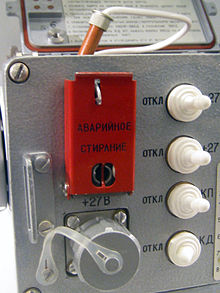Data destruction
Under data destruction is understood processes by which media are treated so that a reconstruction of the original it contains data highly unlikely and is practically impossible. In this regard, data destruction can be seen as part of data protection .
Basically, the following use cases can be distinguished:
- The physical destruction of the data carrier (e.g. by shredding ),
- of conventional, non-electronic documents such as card files , computer lists , forms and files of any kind,
- as well as electronic data carriers .
- In the case of digital storage media, the overwriting of data in order to technically no longer be able to reconstruct the original content of deleted files . In information technology , this is also known as secure deletion or physical deletion .
When destroying data, depending on the type of data, certain regulations must be observed, for example the Federal Data Protection Act or the rules issued by the Federal Office for Information Security .
Data destruction is partly offered and carried out by specialized companies as a service.
overview
The type of data destruction depends on the respective data carrier type . It can prove difficult in individual cases. In this way, fragments of paper that were created by the paper shredder can be put back together under certain circumstances. Such processes are nowadays partly automated. Even after an acid bath and other destructive measures, the contents of a hard drive can still be read in many cases, but mostly only by special data recovery companies . However, if the data is overwritten with random data or bit patterns, not even professional data rescuers are able to reconstruct them. The probability of correctly restoring a single bit is 56% after overwriting the data once , with a whole byte (8 bits) the possibility is only 0.96%.
Procedure for paper
Destroying digital data carriers
There are various methods for this, depending on the data carrier:
-
Magnetic data carriers (e.g. hard drives):
- Heating to at least the Curie temperature
- the physical destruction of the data carrier in the shredder
- direct violence (ax or similar, in the military sector as an emergency measure)
- Optical data carriers can be destroyed by physical effects such as heat or shredding; see also Compact Disc #Destruction of data .
Overwriting of data ('Secure Erase')
The usual "deletion" of files by the operating system usually only removes the entry of the file and marks the storage space as free; this is also called 'logical deletion'. The actual data is retained and can be reconstructed with special programs as long as the area has not yet been overwritten. If this should or must be prevented due to the special need for protection of this data, it is possible to overwrite this data using special system programs (called ' erasers '). The object of this overwriting is not individual files, but entire data carriers or partitions .
- New hard drives encode the data so compactly that simply overwriting the data with zeros can no longer reconstruct the content, even with modern laboratory methods. If the hard drive is old (less than 15 GB or manufactured before 2001), more passes are required.
- Optical data carriers (e.g. CDs and DVDs) can be "overburned" using some CD burners (only writable CDs)
- With flash memories such as solid-state drives or USB sticks , overwriting the data does not work reliably due to wear leveling . For details, see the main article Solid State Drive . With some devices, you can instead securely delete the contents of the device by setting and deleting a password. If the device can no longer be written to, only physical destruction is a safe protective measure, which is becoming increasingly difficult due to the small structures and hard chips.
As an alternative to 'secure deletion' - depending on the desired data protection - the data content can be encrypted before logical deletion . However, the data is still available on the data carrier, albeit encrypted. Your security then depends on the chosen encryption method and password.
Web links
- Secure deletion of data carriers from the basic protection manual of the Federal Office for Information Security
- Topic Secure deletion in the information portal Consumers Secure Online ( TU Berlin , funded by BMELV )
- BSI rules as of 2010
Individual evidence
- ↑ How often must data be deleted?
- ↑ Overwriting Harddrive Data - The Great Wiping Controversity ( Memento of the original from December 14, 2013 in the Internet Archive ) Info: The archive link was inserted automatically and has not yet been checked. Please check the original and archive link according to the instructions and then remove this notice. (PDF)
- ^ A b Kissel, Richard, Andrew Regenscheid, Matthew Scholl, Kevin Stine: SP800-88 Rev. 1 Guidelines for Media Sanitization (PDF) In: Computer Security Division, Information Technology Laboratory . National Institute of Standards and Technology . December 2014. Retrieved January 18, 2018.
- ↑ https://www.heise.de/ct/hotline/SSD-komplett-loeschen-1427587.html
